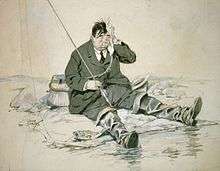Tony Sarg

.webm.jpg)
.webm.jpg)
Anthony Frederick Sarg (April 21, 1880 – February 17, 1942), known professionally as Tony Sarg, was a German American puppeteer and illustrator. He was described as "America's Puppet Master", and in his biography as the father of modern puppetry in North America.
Sarg was born in Cobán, Guatemala, to Francis Charles Sarg and his wife, Mary Elizabeth Parker. The elder Sarg was a consul representing Germany; Parker was English.
The family returned to the German Empire in 1887; Sarg entered a military academy at age 14 and received a commission as lieutenant at 17; in 1905 (in his mid-20s) he resigned his commission and took up residence in the United Kingdom, where he pursued a relationship with Bertha Eleanor McGowan, an American he had met when she was a tourist in Germany. They were married in her hometown of Cincinnati, Ohio, January 20, 1909, and returned to England where their daughter Mary was born two years later. In 1914, with the start of World War I, he sent Bertha and the children to Cincinnati, followed them soon after, and settled the family in New York City in 1915.
He had been raised around puppets, inherited his grandmother's collection of them, developed them as a hobby that enhanced the impression he made on other artists, and finally in 1917 turned them into a profession. In 1920, he became a naturalized citizen of the United States.

In 1921, Sarg animated the film The First Circus, an inventive cartoon for producer Herbert M. Dawley, who was credited as co-animator.
In 1928, he designed, and his protégé Bil Baird built tethered helium-filled balloons up to 125 feet (40 m) long, resembling animals, for the New York institution of Macy's department store, involving a number of issues familiar from puppetry; these participated in the store's Thanksgiving Day parade. In 1935, he undertook the puppet-related work of designing Macy's elaborate animated window display between Thanksgiving and Christmas.
The pinnacle of Sarg's visibility was at the 1933 Chicago World's Fair, where his cumulative audience was 3 million; Baird was heavily involved in this production, as were Rufus and Margo Rose. Those three left his studio that year to start a new one themselves.
Sarg no longer innovated as much as competing puppet studios, and his economic fortunes declined as others gained a following; he both went into bankruptcy, and mounted his last production, in 1939.
In mid-February 1942, Sarg had surgery for a ruptured appendix, and died three weeks later of complications arising from it. He is buried at Spring Grove Cemetery in Cincinnati, Ohio.
The Academy Film Archive has preserved several of Tony Sarg's films, including "The Original Movie," "When the Whale Was Jonahed," and "Why Adam Walked the Floor."[1]
See also
References
- ↑ "Preserved Projects". Academy Film Archive.
- 2007. "FANFAIR - 31 DAYS IN THE LIFE OF THE CULTURE - Life Sketches -- Tony Sarg's New York Illustrations. The Cultural Divide. Elissa Schappell's Hot Type. My Stuff -- Lauren Bush; A. M. Homes on Lillys New Men's Wear. Krista Smith Exposes the Hotties of Robert Rodriguez and Quentin Tarantino's Grindhous; Bruce Handy Warms Up to Hot Fuzz. Matt Tymauer Has Designs on Moss. Graham Fuller Reviews the Edith Piaf Biopic; Giving Back with Green Jewels. Frank DiGiacomo on the Iggulden Brothers' Lost Childhood; Lisa Robinson Meets The Actual. Leslie Bennetts on Elettra Rossellini Wiedemann's Eco-Education; Amy Larocca on Olivia Chantecaille's Undersea Odyssey; Hot Looks". Vanity Fair. 75.
External links
| Wikimedia Commons has media related to Tony Sarg. |
- Works by Tony Sarg at Project Gutenberg
- Works by or about Tony Sarg at Internet Archive
- 'Letter of Apology to Bert from This Wretch' Tony Sarg Writes from London, by George Korn
- Tony Sarg in Nantucket: Nantucket Historical Association Digital Exhibition
- Photographs of Tony Sarg's Sea Serpent on Nantucket